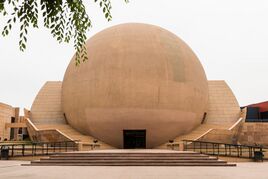Chornostalsk
This article is incomplete because it is pending further input from participants, or it is a work-in-progress by one author. Please comment on this article's talk page to share your input, comments and questions. Note: To contribute to this article, you may need to seek help from the author(s) of this page. |
Chornostalsk
Чорностальськ Chornostal's'k | |
|---|---|
| Country | Soravia |
| Top-level subdivision | Novaydar Oblast |
| Founded | 1951 |
| Government | |
| • Mayor | Leonid Meshcheryakov (PF) |
| Population (2023) | |
| • Total | 132,649 |
| Time zone | UTC-3 (OST) |
Chornostalsk (Soravian: Чорностальськ; Chornostal's'k) is a city in Novaydar Oblast in Soravia. It has a population of 132,649 as of 2022, making it the second-largest city in the oblast behind its administrative centre, Novaydar.
The city was founded in 1951 to house several new steel factories, which gave the city its name. The city expanded rapidly in the late-1950s, with the Puramapese architect Martian Detchepare designing a number of the city's now-prominent buildings, including the Chornostalsk City Hall and the Effigy to Equality in the Republic. With a wide grid plan throughout the city, Chornostalsk became a leading example of modernist urban planning in Euclea, particularly in the West.
Chornostalsk is located in Western Soravia, at one of the widest points on the Kvasy river.



